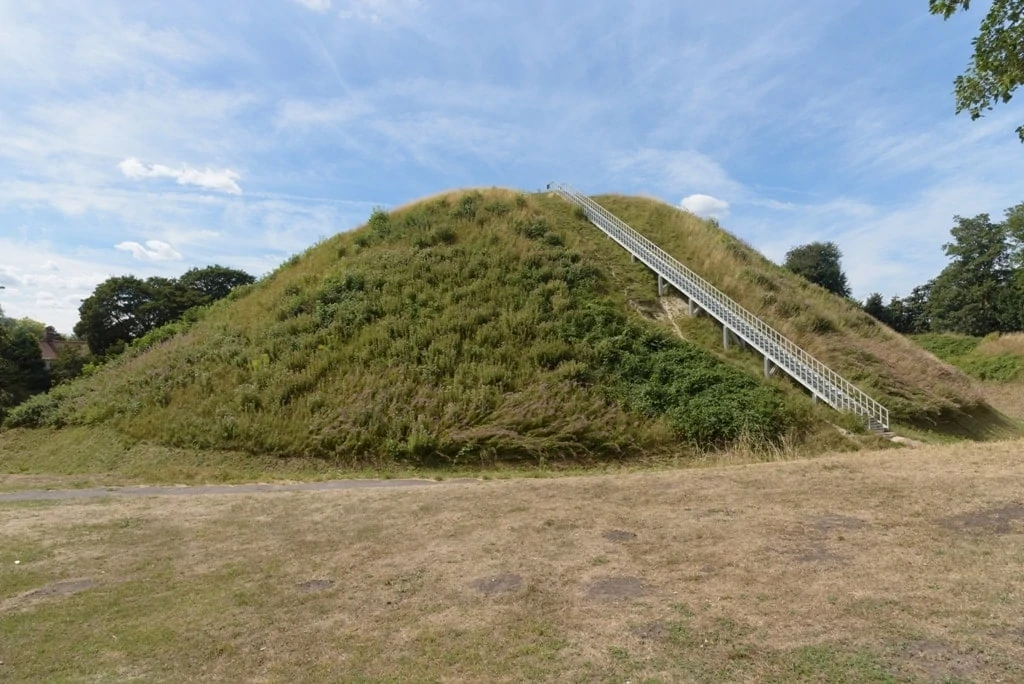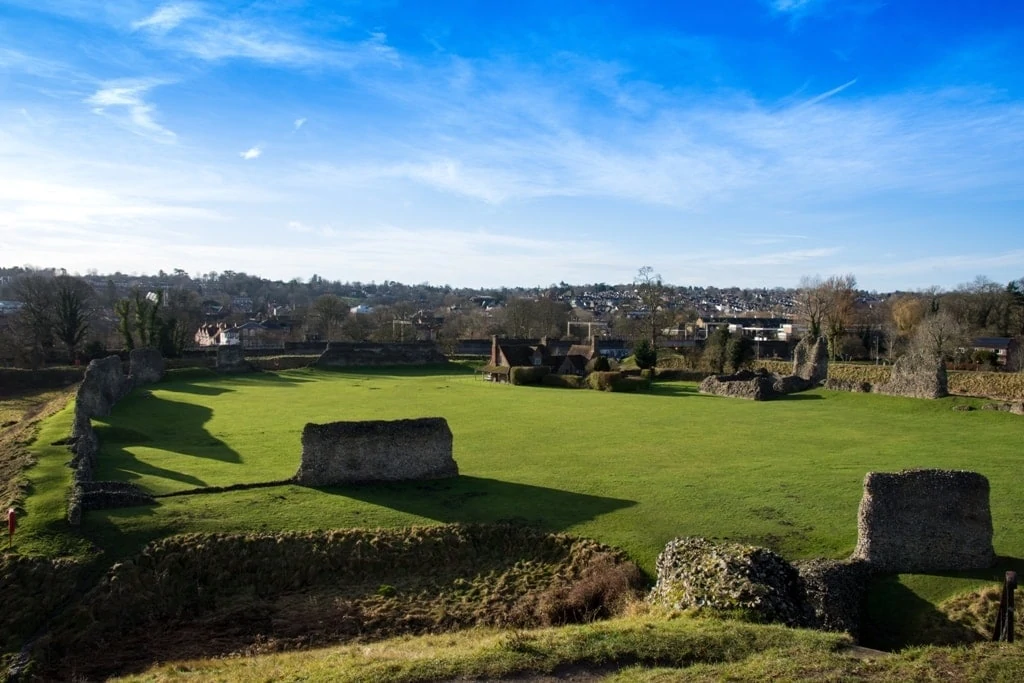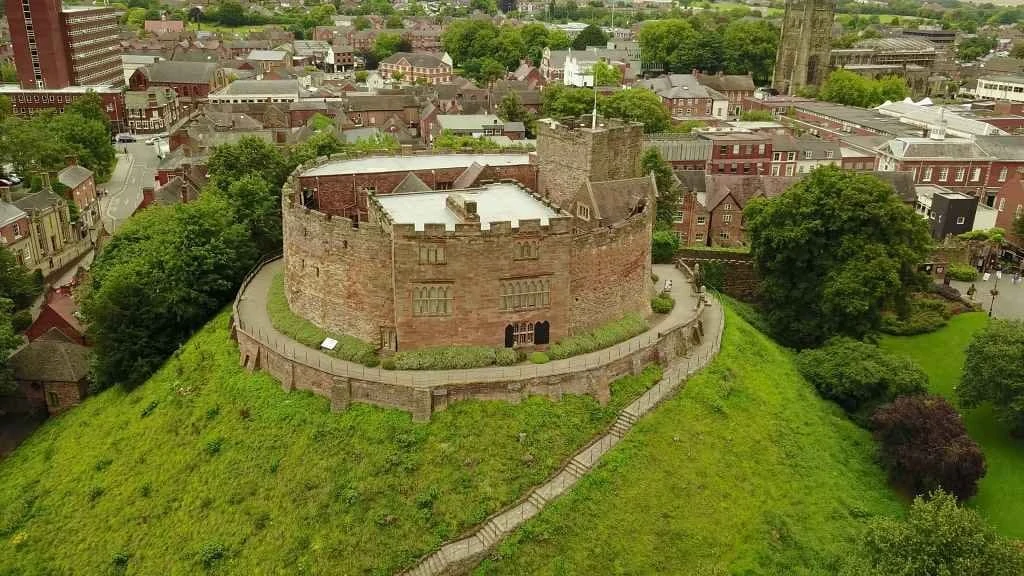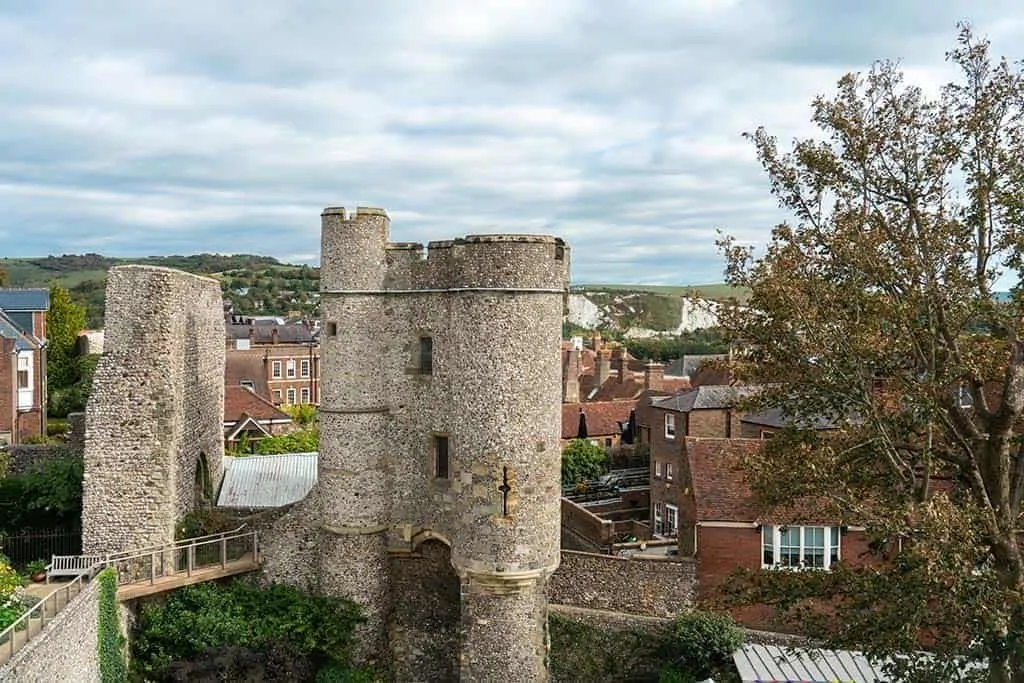Castles began to emerge in Europe as early as the 9th century, but the first structures that we can truly call ‘castles’ were motte-and-bailey fortifications.
These were the earliest iterations of the castle in the Medieval period, a building that would later develop the imposing stone towers and thick walls which we are so familiar with, and which are synonymous our ideas of with the middle ages.
Essentially, motte-and-bailey castles were made up of a motte, a large earthwork – atop which stood a (usually wooden) keep – and a bailey, a compound beside the motte, containing various buildings and surrounded by some form of wooden fencing.
A Guide to Motte and Bailey Castles
Origins of the Motte and Bailey Castle
Various theories have been suggested to explain why castles became increasingly popular in the 9th-11th centuries across Northern Europe. Some scholars have suggested that wide-scale raiding from Scandinavian Vikings, as part of the Viking age lasting from the late 8th until the mid-11th century, led to the creation of castles.
In the Saxon kingdom of Wessex for example, King Alfred the Great built a network of burhs in the 9th century, although these were fortified towns rather than castles.
Alternatively, others have pointed to the collapse of the powerful Carolingian empire in the late 9th century as the reason behind the sudden proliferation of castles.
With the weakening of the Carolingian emperors came a break-down in central authority – in such an atmosphere of political instability, local lords had to look to their own devices to secure their lands from rival lords and foreign raiders.
Building castles was an excellent method to protect their interests militarily, but they also represented a way for landowners to stamp their authority on the landscape and impress their subjects.
The rise of the castle is also closely linked with the rise of the feudal system, a structure in which societal relationships were based around landholding in return for labour or military obligations – Lords would grant subjects protection and the right to live on their land in return for labour and military service.
In the feudal system, land was the most important resource, and motte-and-bailey castles were the most effective early method of securing land.
Etymology of the Motte and Bailey Castle
The name ‘motte-and-bailey’ is not medieval in origin but is a later identification. Generally, in contemporary medieval sources the Latin word castellum (signalling a small fort or tower), a diminutive of castrum (‘military fort’), was used to label motte-and-bailey castles.
The word ‘motte’ is a French derivative of the latin word mota – initially it was used to refer to turf, before becoming the word for a turf bank, and later it became synonymous with the large earthworks typical in motte-and-bailey castles.
The word ‘bailey’ also has a French origin, it comes from the Norman-French word for a low yard: baille or basse-cour.
Parts of the Motte and Bailey Castle
The Motte
Motte is the name given to the large earth mound which forms the basis of a motte-and-bailey castle. These mottes could vary greatly in size, reaching up to 90 metres in diameter and 30 meters in height, although generally they were much smaller than this.
Generally, earthworks under 3 metres are not considered mottes as these often had different, non-military uses. To give an idea of the average size of mottes in England, the vast majority were between 3-5 metres tall (69%) – 24% were between 5-10 metres tall, and only 7% of the mottes in England which are recorded measured above 10 metres.
In order to save time and resources constructing the motte, castle builders would often use or incorporate natural earthworks, such as small hills, or existing man-made earthworks, such as burial barrows from the Bronze Age.
Using a pre-existing hill could save a great deal of time that would need to be spent on constructing an artificial motte, and the sides of the hill could have ‘scarping’ added quite easily; that is, the slopes of the hill would be smoothed at a steep angle to make ascending it harder for attackers.
If no natural hill was available, a motte would have to be built by hand by labourers using spades, picks and barrows (the Bayeux Tapestry depicts the motte-and-bailey castle at Hastings being constructed using this method).
A ditch was also dug around the base of the motte, and usually, the earth excavated to dig this moat was used to build the motte itself. Larger mottes took far longer to build than small ones due to the large amount of earth that needed to be moved – the motte at Thetford castle, the second-largest in England, was estimated to have required 24,000 man-days of work to build.

Historians have also estimated that large mottes probably required somewhere between four and nine months to construct, depending upon the amount of labour available. Due to the unskilled nature of the construction work, unpaid peasant labour could be used, keeping the costs down.
The soil type also had a bearing on the construction of the motte. Clay rich soil would allow the motte to be built with a steeper incline, making assaults harder for attackers, whereas sandy soil was less stable and would require a motte with a shallower incline.
Similarly, the broader the ditch at the base of the motte, the steeper its sides could be, and the greater its defensive effectiveness was. The motte could be made more stable by adding layers of turf, clay, gravel and chalk, and sometimes a motte would be built up around a base of stones to make it even more stable.
The Keep
The keep was a free-standing fortification, usually a tower, built on top of the motte, which was levelled to make room for the keep. Initially, keeps were constructed of wood, although stone keeps soon emerged in the 11th century.
The keep itself varied greatly in size and complexity – some were simply small wooden towers which could house a few soldiers, whereas others were far larger constructions with several rooms.
Wooden keeps often featured small balconies known as bretèches or brattices, which would allow soldiers to shoot down onto approaching enemies. As these balconies projected out away from the building, they had the potential to give the defenders an excellent line of sight.
Typically, a wall made of wood would also be constructed around the edge of the motte – sometimes these walls were thick enough to allow soldiers to walk along them, in which case the wall could be filled with earth and stone to strengthen it, forming what was known as a garillum.
To protect the wooden keep against fire in the event of a siege, skins and hides were often draped over the outer walls.
French chronicler Lambert of Ardres, who was active at the end of the 12th century, wrote an account of a contemporary keep at the motte-and-bailey castle at Ardres in his History of the Counts of Guines.
He described the ground floor being given over to cellars and granaries for storage, while the first floor contained the chambers of the lord and lady, rooms for bakers and butlers, as well as larders and common living rooms. The top floor rooms were reserved for servants and soldiers.
Like the motte, wooden keeps required very little skilled labour and were therefore relatively cheap and easy to build – in this way they had one great advantage over stone keeps, which usually took up to 10 years to construct.
The method by which the keep was added to the motte varied too: The keep could be built on top of the motte, or the keep could be built first and the motte constructed around it, half burying the wooden structure and strengthening it further.
The Bailey
The bailey was an enclosed compound, usually constructed adjacent to the motte and keep. The shape of this compound varied greatly and often depended upon the terrain – typically the bailey was ‘kidney-shaped’ to fit up against the circular motte and keep the entire fortification compact.
A palisade, a wall made of wooden stakes, surrounded the bailey, and a ditch or moat was dug outside. Usually, this ditch connected with the ditch at the base of the motte.
In some cases, it would also be filled with water in order to hinder attackers further. This could be achieved by diverting local rivers or streams. In practice baileys varied greatly in design and appearance, usually due to differing local geography: Windsor Castle had several baileys flanking its central motte, while Berkhamsted castle had two sets of ditches.

The bailey itself contained a series of buildings, usually economic in nature. Kitchens, stores, stables, forges and workshops could be found here, as well as military constructions like barracks and religious buildings such as chapels.
By gathering the key productive, military and religious buildings in his realm, a lord was able to effectively defend the economic activity of his fief.
Access to the bailey was usually gained by crossing the ditch or moat surrounding it via a bridge. Similarly, the motte and keep would often have a bridge connecting them to the bailey, or else steps were cut into the motte itself.
Examples of Motte and Bailey Castles
Tamworth Castle Lewes Castle
Advantages of a Motte and Bailey Castle
Perhaps the primary benefit of the motte-and-bailey design was the relative speed and ease with which they could be constructed. With a usual build time of four to nine months, these castles could allow a lord or king to rapidly lay claim to a newly captured territory, or else impress the inhabitants of his land with a formidable fortification.
The use of earth and wood in the construction of motte-and-bailey castles kept costs low, as these materials were freely available. Repair work was also easy to carry out.
Furthermore, skilled craftsmen were not required, so peasant labour could be utilised (these workers would typically not need paying, as they owed service to their lord).
In addition to this, despite their cheap cost, motte-and-bailey castles had formidable defences. Even the smallest fortification presented a huge obstacle to an invading enemy and would have needed a large concentration of troops to capture.
Even in the event of an assault, besiegers could expect to take heavy casualties attempting to storm a motte-and-bailey castle – the combination of ditch, wall and earthworks slowed attackers and made them easy targets for the missiles of defending troops.
Until siege technology developed, motte-and-bailey castles remained highly effective defensive structures.
Disadvantages of Motte and Bailey Castles
Although they were relatively simple to construct, motte-and-bailey castles required a great deal of maintenance. Soil from the motte could wash away, eroding the defences and reducing their effectiveness – to combat this, mottes were sometimes covered in wood or stone.
Mottes could also be affected by the ground subsiding or flooding, problems which would require a great deal of work to repair. Similarly, the wooden elements of the motte-and-bailey were vulnerable to the weather and would rot away, potentially requiring frequent rebuilding.
Although measures could be taken to combat fire damage, such as covering walls in hides or skins, wooden motte-and-bailey castles did remain somewhat vulnerable to enemy attempts to burn them.
Furthermore, while it was a strong material, wood was soon outmatched by advances in siege technology. Simple wooden palisades were no match for siege engines hurling large rocks.
Spread and Decline of Motte and Bailey Castles
As mentioned previously, motte-and-bailey castles were extremely popular in the 11th century. The lords of Anjou in France were prolific early builders of motte-and-bailey castles, in particular, Fulk III and Geoffrey II.
It has been suggested that William the Conqueror, Duke of Normandy, adopted the motte-and-bailey design from neighbouring Anjou – it was certainly William that brought the design to England following his conquest of the kingdom in 1066.
Most of the castles that William constructed in his new realm were in this style and were designed to impress upon local inhabitants the power of their new Norman overlords.
In response, Welsh lords also constructed some motte-and-bailey castles in the 11th century, such as Tomen y Faerdre. Similarly, the Normans constructed many such castles during their invasion of Ireland, which began in the late 1160s.
During the first half of the 11th century, the design spread south to the Alps, and from there into Bohemia and Austria. The use of motte-and-bailey castles was also widespread in Germany during the 11th century.
During the 12th and 13th centuries, there was a great increase in motte-and-bailey castles appearing in the Low Countries, primarily due to increased warfare in the region – the lower Rhine, in particular, was a highly contested area.
Motte-and-bailey castles also began to appear in Denmark at this time, although in fewer numbers, perhaps because feudalism was less widespread there. Thanks to the Norman influence in southern Italy and Sicily, a small number of castles were also built there.
Slowly motte-and-bailey castles became less popular. Mottes stopped being built in England after around 1170, and in France at the beginning of the 12th century.
Primarily the reason for the decline of the motte-and-bailey castle was the increasing use of stone as a castle building material – although wooden castles were strong, stone castles were even more formidable, and also served as a powerful status symbol.
Some existing motte-and-bailey castles were converted to stone, and sometimes shell keep castles were constructed on existing mottes. However, the enormous weight of these new stone castles simply could not be supported by many mottes, and they regularly had to be built in new locations on more stable ground.
Later concentric castles rarely made any use of mottes and keeps, making the motte-and-bailey design increasingly obsolete. By the late 13th and 14th century, the motte-and-bailey had fallen out of fashion altogether, and they were no longer constructed.


